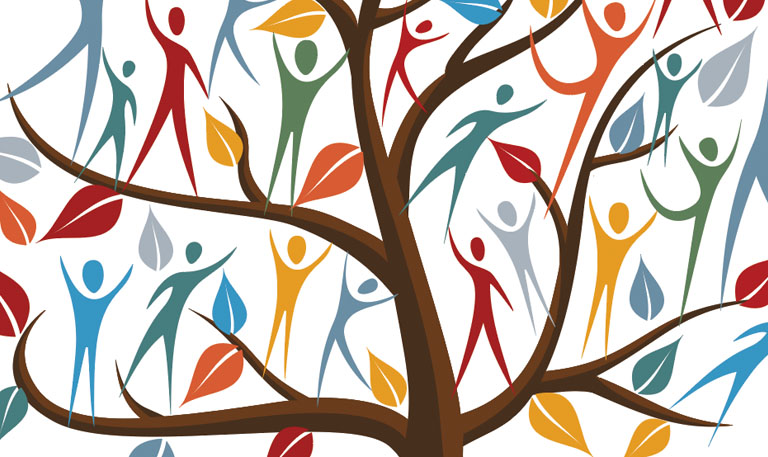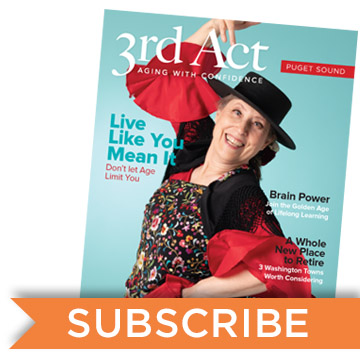BY KATHY WEBER
I didn’t know what would follow my beloved career of nearly 40 years—after my early retirement and successful transition to the next generation of professionals. Then I discovered genealogy.
I am intensely curious about people. Where are you from? What experiences have influenced you? What’s your story? If we met, I’d want to know. Our conversation would likely lead us to answers to these questions. I have always loved a good jigsaw puzzle that can engross me for days. I am willing to be surprised.
Inquiring minds wonder. Why did my great-grandpa H. W. Davis, Jr. build a wooden boat in 1930? What did grandpa Dick mean when he told me his ancestors immigrated to North America a long, long time ago? Why did my grandma Weber always say she was from Monaghan, Ireland, when her mother was born in Starbuck, Wash., and her father wasn’t Irish? How could a DNA test help me find unknown ancestors born more than 200 years ago and cousins I never knew I had? I had so many questions—and I now had time to learn!
Genealogy is perfect for me. It’s the marriage of being curious about people, working complex puzzles, and occasionally incorporating surprising new family data into my identity. It connects me to thousands of people around the world and broadens my understanding of who my family is.
I am extending the branches of my family tree, and as I do, my tree grows stronger and I feel more grounded knowing more about those who came before me. I’ve also shed new light on family stories or passing comments, and gained new insights about the times and places of my ancestors’ lives. As I study context of a time and place, history comes to life. It would have been more interesting when studying the Civil War in high school history to realize which of my family members were fighting for the cause. I have more appreciation for my ancestors, their strength, resilience, and courage. They’ve become human to me, more than a collection of names and dates, as I now understand more details of their lives.
In genealogy, one thing leads to another
While researching H.W. Davis, Jr.’s move to Seattle, I learned that he forgot to pick up his mother’s ashes at the funeral home in 1927. How did he forget his mother’s ashes? The death of his wife, father, and mother occurred within three short years. Was he too busy planning for the design and construction of his new boat, m/v Comrade? Kate Davis, born in 1843, was not interred— her remains sat in a box in the basement of a Seattle crematorium for more than 95 years. While researching, I discovered this fact. I got to be the instigator of her funeral, for the burial at sea conducted from Comrade! (https://vimeo.com/845000873)
We’ve been here a long, long time
Early colonial Americans are well-researched, but no living person in my family realized we descended directly from four of the passengers on the Mayflower: Samuel Fuller with his parents, and Richard Warren, preparing a new home for his wife and daughters to join him. This is what grandpa Dick must have meant when he said his “family had been here for a long, long time.” He couldn’t recall any specifics for my fifth grade family tree homework assignment. I now have new insights about our deep roots in North America, which are likely correlated with discovering my African American DNA cousins. This is an area of ongoing interest and exploration, and gives me a more direct connection to the African American experience. It was initially a surprise finding, but now I simply like being more connected to more people.
DNA opens doors
I knew little about grandma Weber’s County Monaghan heritage and was surprised to learn that her Monaghan roots were connected with only one of her four grandparents, as it was a significant part of her identity. I decided to use my DNA test results to explore her Monaghan heritage and what a treasure that’s been. Especially, when I was invited to attend a gathering of the family of her great grandmother in Monaghan. A month in Ireland in 2022 included meeting dozens of cousins and lots of laughter. I discovered the source of my dad’s sense of humor. He died in 2016 and spending time with these Irish cousins was nearly like having him in the room with me again! I now have regular conversations across the Atlantic.
It’s not all good news
When a DNA match led me to correspond with a newly discovered third cousin, I was sad to hear that her grandmother had been abandoned by her husband, our shared relative, with small children to raise by herself. This happened more than 100 years ago. When a distant Irish cousin has a very non-Irish sounding surname, I became curious and learned that his father died while his mother was pregnant with him. Already having five children under age eight, he was put up for adoption and grew up thousands of miles away. He and I have roots in the same 19th century “neighborhood” in rural Ireland.
And there are surprises
Brought up Catholic, and believing we were all always Catholic, I was stunned to see 5% Ashkenazi Jewish ethnicity in a DNA test. I learned that one third great-grandmother’s Jewish husband converted to Catholicism on their wedding day. “Why did that occur?” is another question to contemplate. On that day in 1823 when John married Catharina in present-day Germany, who would have known the thrill of discovery for me 200 years later.
Kathy Weber is a professional genealogist, based in Kirkland, Wash. She is Vice President of the Board of Directors of the Seattle Genealogical Society. Her book, Arrivals: How My Great Grandparents Got to Washington 1882-1909, will be published in 2024. She can be reached at liverpoolstreetpublishing@gmail.com.
A little more on how I use and practice genealogy.
Using DNA evidence in my research is my favorite tool. It’s like working a jigsaw puzzle that includes outline pieces rather than a puzzle without any straight-edge pieces. Anyone who works jigsaw puzzles probably starts by collecting the straight-edge pieces and forming the outline so all the other pieces will fit inside.
All our DNA came from our direct genetic ancestors, so DNA helps point the way to who they are, especially when used in collaboration with the DNA of our family members. I work with a cluster of shared DNA matches to try to identify our common family. Alternatively, I study a specific segment of DNA and the people who share it, as a tool to seek a common ancestor.
I attend the Seattle Genealogical Society DNA Special Interest Group on Zoom, where I learn new skills, ask questions, and decide what my next steps are in my DNA education. (https://seagensoc.org/cpage.php?pt=81)
Tips on How to Get Started with Family History Research
-
Decide where you will record your family tree research results such as on paper or online. Good ideas for online are Wikitree, FamilySearch, or Ancestry. Or get your own software to record your results in Family Tree Maker.
-
Document what you already know. Include full name (at birth), date and place of birth, marriage, and death. List names of known children.
-
Interview parents, aunts and uncles about family history. Write down what they say with details for future reference.
-
Take a DNA test at Ancestry.com. They have the largest database of testers so you will have the most matches to work with. Also test any living parent.
-
Choose one area to focus on. Read about the time and the place for historical context. The research wiki at FamilySearch is a great resource for learning about a location.
-
Look for ways to learn more. Join a genealogical society such as Seattle Genealogical Society and a special interest group in an area of interest. Consider joining Family Tree Webinars and viewing Family History Fanatics on YouTube.
-
Prepare to be surprised.
More stories on family and ancestors:
Summon Your Ally Superpower—My ancestors made decisions that led to my current life and circumstances. In turn, I imagine the voices of my great, great, grandchildren—the “future ones”—in my ear and in my heart, urging me to consider their needs as I make choices today.


